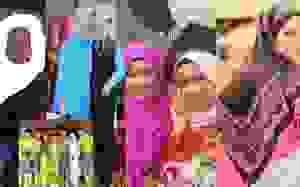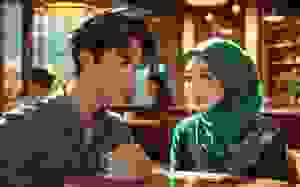Snap Judgments And Stories We Tell Ourselves
I bought a few keffiyehs in New Delhi years ago for my millennial son. Back then, many perceived the keffiyeh as simply a neck warmer, a casual fashion wear. It was nothing more than a soft black-and-white chequered fabric.
Yet today, a keffiyeh carries different meanings. To some, the scarf affirms one’s solidarity with oppressed Palestinians. To others, it signals anti-Semitism. A hostility towards the occupier, Israel.
Likewise, flying the Jalur Gemilang upside down - a traditional gesture to mark distress - is quickly condemned as an affront to ketuanan melayu, an insult to national pride, hence a prosecutable offence. And the yellow Bersih T-shirt, a reformasi marker, is also a signal of anti-government activism.
All these examples share a simple truth: a single item connotes many meanings in an open field of grand conspiracies.
ADSWe first react to what we see, not reflect on what lies within. An image online, viral clips on Instagram, short reels on TikTok. Doom scrolling frames our judgments regardless of the nuances and contexts of what was recorded, at times AI-generated.

Our snap judgments harden around the fragments. Deeper understanding goes out the window. (This, of course, excludes the blatant symbols of hate: the Nazi’s swastika, the burning Cross of the Ku Klux Klan).
The late Nobel laureate, Daniel Kahneman, spent a lifetime studying these mental shortcuts. In “Thinking, Fast and Slow”, which I am re-reading in parts, he described how our minds are “primed to find flaws” - the System 1 mode of thinking.
Our brains, he found, gravitate to bad news. Even symbolic threats trigger swift reactions. Words associated with discord and distress - conflict, crime, race, religion and, I might add, homosexuality - seize our attention more quickly than words of harmony.
(Remember the Umno-PAS’ weaponisation of the word “Allah” used in Christian literature and inadvertently appliquéd in KK Super Mart socks, protests against the building of churches and mandirs in predominantly Malay suburbs, the seizure of rainbow-coloured Swatches?)
No surprise then that symbols and particular words take on such emotional force. Each is pulled into a contest of meanings, far beyond what the object itself was designed to carry.
In semiotics, this is known as “referential fallacy”. We confuse a symbol with the reality it points to. We make this mistake instinctively. A symbol becomes the thing. A person becomes the stereotype. A community becomes the threat.
Power of symbols
This plays out quietly in our social habits. Let me pose a few questions here related to race relations. They may seem trivial, which, I think, is revealing of who we are.
When did we last invite a neighbour of another ethnicity into our home? Whom do we usually lunch with at work? How many names in our contact list are of people outside our inner circle? Which neighbour would we prefer or avoid - and why? Do we encourage our children to play with kids from other ethnicities or social classes?
These questions point to something deeper within. We self-segregate. We retreat to familiarity. And in that retreat, we reinforce divisions in private what we claim to oppose in public.
We tell ourselves we oppose racial discrimination, yet our lived habits often sustain it. The gap between what we believe and how we behave widens, quietly but steadily.
ADSThe products of such thinking are everywhere - in schools divided by language, in universities shaped by racial quotas, in workplaces coded by hierarchy, and in the racialised rhetoric that echoes through Putrajaya. Populist politicians are at the core of the problem.

Politicians know the power of symbols. They know that in times of uncertainty, people respond instinctively to narratives of threat, identity, and protection. System 1 thinking is weaponised.
Even our public intellectuals fall into this pattern. The Group of 70 Malay professors who endorsed Anwar Ibrahim as prime minister illustrates how quickly scholars can retreat into shared ethnicity, which a university education ought to interrogate.
Academia, ideally a space for System 2 thinking - the rational, analytical, and reflective mode - is not immune to snap judgments and identity politics.
In social psychology, this instinctive disassociation is known as anticipatory or retaliatory perception. It is the quiet inner voice that says, “You probably won’t like me, so I won’t like you.”
Or “You won’t understand me, so I won’t bother trying to understand you.” This is how mistrust grows - not in dramatic confrontations, but in unconscious self-segregation and gradual withdrawals.
Yes, reaching out to the “Other” is often uncomfortable. Building bridges over a history of institutionalised discrimination can be slow and imperfect. What is more achievable is this: pause before judging, listen before assuming, reflect before reacting.
It calls us back to System 2 thinking, even when System 1 feels more satisfying.
What can journalists do?
This is where journalists can bridge the divide with deeper contextual reporting. Too often, conflict-driven personality-oriented reporting falls into the rhythm of System 1: Quick quotes, reactive headlines, the formulaic “he said, she said”.

Little space is left for the harder questions: What are the underlying issues? What are the structural causes? What does it mean for ordinary people? What alternatives exist? Why, and how, can they be resolved?
We forget that journalism’s value lies not only in recording events and transcribing what politicians say, but in making sense of what they claim. Should journalists resurrect the investigative spirit of the reformasi era, when online portals for a while filled the gaps left by compliant mainstream media?
Should not journalists dig into systemic cronyism, examine the hard data behind wealth distribution, and question policies - for instance, the inequitable distribution of wealth among the B40 Malays under the New Economic Plan - that are often invoked but rarely scrutinised in depth?
Should readers actively question the journalists’ stories? Challenge the inconsistencies? Flag the errors – both in the context and interpretation?
The answer is “Yes”, a resounding yes to all the above. Journalism is, after all, a shared public undertaking. Journalism is ultimately an act of service - not to the powerful, but to the people who live with the consequences of making snap judgments and the stories we tell ourselves and others. - Mkini
ERIC LOO is a former journalist and educator in Australia and a journalism trainer in parts of Asia.
The views expressed here are those of the author/contributor and do not necessarily represent the views of MMKtT.
Artikel ini hanyalah simpanan cache dari url asal penulis yang berkebarangkalian sudah terlalu lama atau sudah dibuang :
http://malaysiansmustknowthetruth.blogspot.com/2025/11/snap-judgments-and-stories-we-tell.html
 PING BABAB : Raksasa Aggregator Malaysia
PING BABAB : Raksasa Aggregator Malaysia
 Our snap judgments harden around the fragments. Deeper understanding goes out the window. (This, of course, excludes the blatant symbols of hate: the Nazi’s swastika, the burning Cross of the Ku Klux Klan).
Our snap judgments harden around the fragments. Deeper understanding goes out the window. (This, of course, excludes the blatant symbols of hate: the Nazi’s swastika, the burning Cross of the Ku Klux Klan). Politicians know the power of symbols. They know that in times of uncertainty, people respond instinctively to narratives of threat, identity, and protection. System 1 thinking is weaponised.
Politicians know the power of symbols. They know that in times of uncertainty, people respond instinctively to narratives of threat, identity, and protection. System 1 thinking is weaponised. Little space is left for the harder questions: What are the underlying issues? What are the structural causes? What does it mean for ordinary people? What alternatives exist? Why, and how, can they be resolved?
Little space is left for the harder questions: What are the underlying issues? What are the structural causes? What does it mean for ordinary people? What alternatives exist? Why, and how, can they be resolved?




















